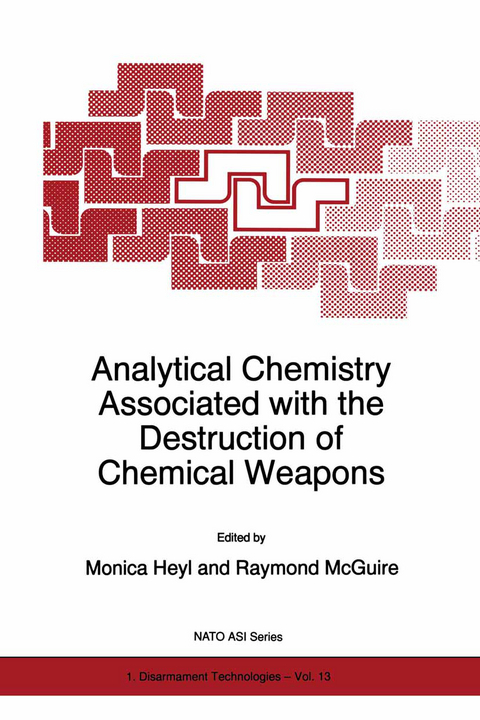
Analytical Chemistry Associated with the Destruction of Chemical Weapons
Springer (Verlag)
978-0-7923-4648-7 (ISBN)
One of the major problems associated with the disposal of chemical weapons is that the agents have degraded over time, some quite seriously. Detecting and identifying the products of this decomposition are necessary prerequisites to the safe, complete and environmentally benign destruction of stockpiled weapons. The book presents and discusses both basic and novel techniques in a variety of areas of analytical chemistry which are relevant to achieving the ultimate destruction of chemical weapons. Presentations address sample collection and preparation, mass spectrometry, chromatographic techniques, NMR, and air monitoring techniques.
The work shows that analytical methods do exist to effectively support the destruction of chemical munitions. While further research is needed, the book provides an excellent baseline for further advances in the field.
Project Swiftsure: Destruction of Chemical Agents at Defence Research Establishment Suffield.- European Experience with the Disposal of Old Chemical Weapons.- Development of Analytical Technologies for the Alternatives to Incineration Program.- Analytical Control for Destruction of Chemical Weapons. Requirements and Organization.- Super Toxic Analytical Glovebox System (STAGS).- On-Site Sample Work-Up Procedures to Isolate Chemical Warfare Related Compounds using Solid Phase Extraction and Solid Phase Microextraction Technology.- Application of Some Modern Sample Introduction Techniques and Poraplot Q GC Column in the Analysis of Volatile Toxic Compounds.- Mass Spectra and Retention Parameters of Some O-Alkyl Methylphosphonic Acids.- Nuclear Magnetic Resonance Spectroscopy for the Verification of the Chemical Weapons Convention.- Chemical Ionization and Electron Impact Mass Spectrometry of Some Methylphosphonothiolates.- GC/MS Investigation of Ethyl S-2-diisopropyl Aminoethyl Methyl-phosphonothiolate (VX) Age Decomposition Products.- GQC GC/MS System: Preliminary Experiences.- System Design Recommendations for the Collection, Transfer and Processing of Real Time Air Monitoring Data.- Air Monitoring Equipment for CW Destruction Facilities with Special Emphasis on OCW Destruction.- Methods and Means for Air Monitoring Associated with the Destruction of Chemical Weapons.- Capillary Electrophoresis.- Determination of Organo Fluoro Phosphonates by Liquid Chromatography.- Analysis of Chemical Warfare (CW) Agents and Degradation Products by Liquid Chromatography (LC).- The Application of LC/ES-MS in the OPCW/PTS Inter-Laboratory Comparison Test.- A Data Analysis Routine to Protect Confidential Information during GC-MS Analysis.- The Role of Remote Sensing Equipment in Air Monitoring System.- Possibilities of Incorporation of the CO2 Dial Detector into the System of Atmospheric Quality Monitoring Associated with Storing and Destruction of Chemical Weapons.- Monitoring in the Non-Stockpile Program.- Hand-Held Chemical Analysis Instruments. An Overview of Vapor Detection and the State of the Art in Hand-Held Detectors.- Screening Techniques for use in the Chemical Weapon Field.- Non-Destructive Evaluation Techniques for Chemical Weapons Destruction.- GC/MS Screening of Alkyl Methylphosphonofluoridates and Alkyl Methylphosphonic Acids.- Appendixes.- Overview of the United States Chemical Demilitarization Program.- Overview of the Chemical Demilitarization Program.
| Reihe/Serie | NATO Science Partnership Sub-Series: 1 ; 13 |
|---|---|
| Zusatzinfo | XIV, 350 p. |
| Verlagsort | Dordrecht |
| Sprache | englisch |
| Maße | 170 x 244 mm |
| Themenwelt | Naturwissenschaften ► Chemie ► Analytische Chemie |
| ISBN-10 | 0-7923-4648-3 / 0792346483 |
| ISBN-13 | 978-0-7923-4648-7 / 9780792346487 |
| Zustand | Neuware |
| Informationen gemäß Produktsicherheitsverordnung (GPSR) | |
| Haben Sie eine Frage zum Produkt? |
aus dem Bereich


